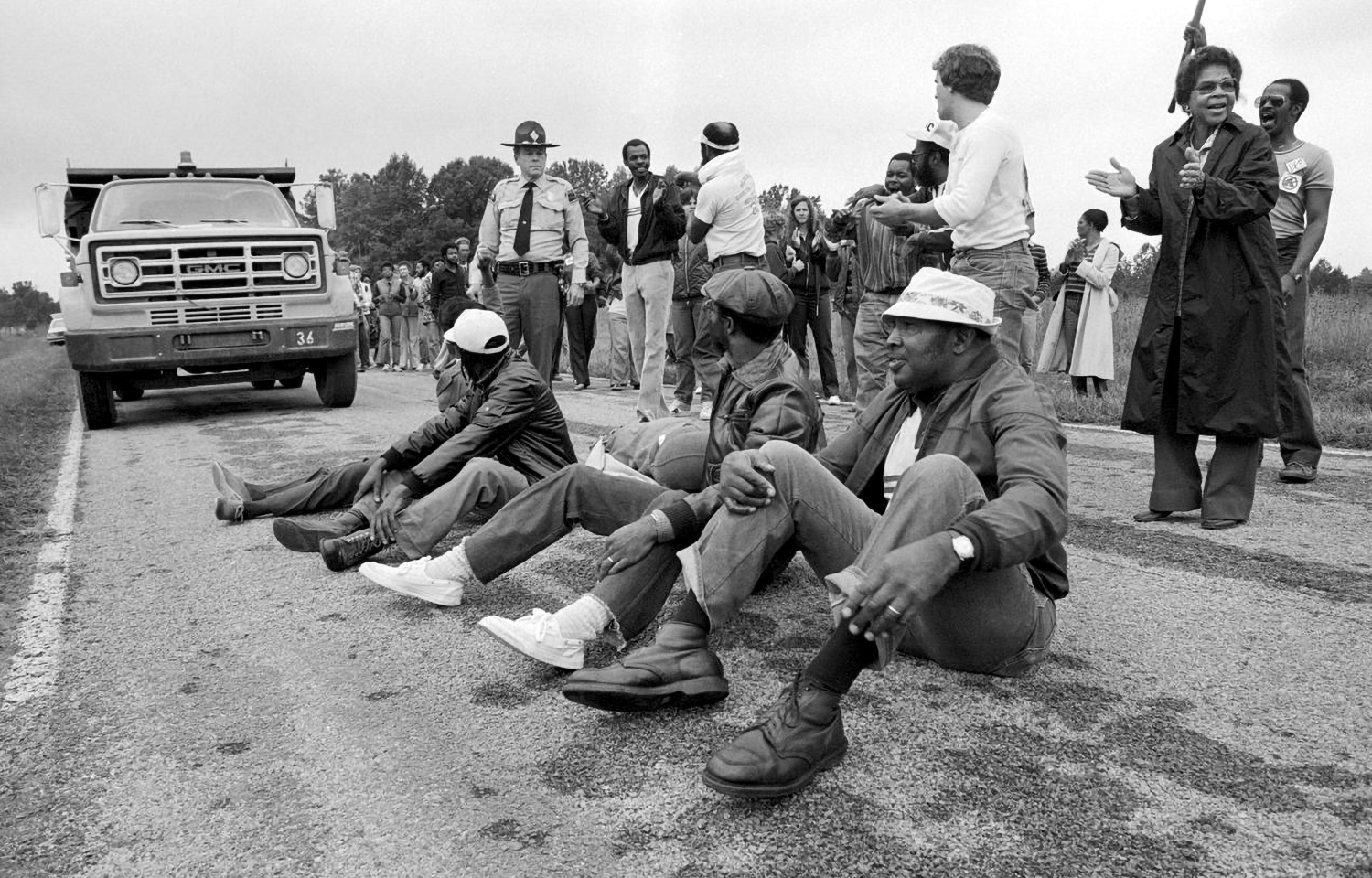
Protestors block the delivery of toxic PCB waste to a landfill in Afton, North Carolina (Photo by Ricky Stilley).
Yen Pham, Eco Rep
Caitlin Griffith, Sustainability Coordinator

Protestors block the delivery of toxic PCB waste to a landfill in Afton, North Carolina (Photo by Ricky Stilley).
In September of 1982, the North Carolina state government decided that Warren County, a rural community made up of a majority of Black citizens, would be the new landfill site for 50,000 tons of soil contaminated with toxic polychlorinated biphenyls (PCBs) – the a result of an illegal PCB dumping incident. The substance was known to cause birth defects, liver and skin disorders, and cancer. State officials had dismissed residents’ concerns over PCBs leaching into drinking water supplies. Because of this, residents gathered in nonviolent street protests and marches. By forcing a toxic landfill onto a small Black community, the North Carolina state government was participating in the racism that Black and other communities of color had faced in housing, education, employment, and so many other places. However, this time it was environmental racism.
The protests of 1982 in North Carolina sparked what we know today as the environmental justice movement. The US Environmental Protection Agency describes environmental justice as “the fair treatment and meaningful involvement of all people regardless of race, color, national origin, or income, with respect to the development, implementation, and enforcement of environmental laws, regulations, and policies. This goal will be achieved when everyone enjoys the same degree of protection from environmental and health hazards, and equal access to the decision-making process to have a healthy environment in which to live, learn, and work.” Environmental justice touches on the majority of UN Sustainability Goals, including Goals #3: Good Health and Well-being, #10: Reduced Inequalities, #11: Sustainable Cities and Communities, #12: Responsible Consumption and Production, and #16: Peace, Justice, and Strong Institutions.
Research shows that it is more common for minority and low-income communities to live in neighborhoods exposed to toxic waste, landfills, air pollution, and other environmental hazards. The locations of pollution sources such as a coal-fired power plant tend to end up in poor neighborhoods that have a greater concentration of minorities.
Source: Disproportionate Exposures in Environmental Justice and Other Populations: The Importance of Outliers American Journal of Public Health, December 2011
A pipeline disrupting indigenous territories, unprecedented levels of lead contamination in a city’s drinking water, a border wall that causes flooding and harms wildlife, and even the determining factor of who is exposed to the COVID-19 virus are all examples of environmental injustice or environmental racism.
No one wants industrial pollution from a factory or a landfill in their neighborhood. However, corporate decision makers, regulatory agencies, local planning boards, and other key stakeholders know that it is easier to place the facilities in low-income communities of color than in primarily White middle-to-upper-income communities. Low-income communities and communities of color, including indigenous communities, typically lack access to decision makers on zoning boards or city councils that could protect their interests. Policies are already stacked against them. Often times, they cannot afford to hire the legal expertise to fight a policy. Furthermore, they often lack access to information about how the pollution could affect their health or what they can do about it. In the case of Latino communities, important information in English-only documents is way out of reach for affected residents who only speak Spanish.
“Environmental Justice. Ricardo Levins Morales, scratchboard, ink, and watercolor.” Photo: Heidi de Vries
When striving to be environmentalists, it is important to consider how some communities are more likely to be exposed to the ramifications of climate change and environmental hazards both directly and indirectly. Taking into account communities that are not protected equitably by environmental laws so that they may have equal access to a safe environment is an important aspect in learning about the environmental movement. Our votes and advocacy can help change this.
Environmental injustice ranges from food deserts (neighborhoods without access to fresh produce) to communities impacted by rising sea levels and oil spills. If you are interested in understanding the wicked problem of food deserts, Green Initiative Committee Chair Genna Campain has an informational video on the food deserts that exist in Dallas.
The attention garnered by the North Carolina protests resulted in a federal review of issues associated with communities and environmental hazards. This culminated in Executive Order 12898, which provided for environmental justice offices in the U.S. Environmental Protection Agency and Department of Justice, among other federal offices.
It takes action to ensure a clean, green future for everyone. You can start by looking into local environmental policy and learning how you can get involved. Here are some grassroots environmental justice organizations that you can explore to learn more: